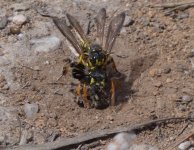thomasclark1985
Well-known member
Hi,
I was on Aylesbeare RSPB reserve in Devon the other day, and witnessed a small wasp riding on the back of a larger wasp, carrying a weevil.... the smaller wasp was persistently smashing the larger wasp (with weevil) into the ground and wrestling with it, whilst another wasp was attacking all 3 of them. The smaller one riding on the back of the larger one eventually won the epic battle after a few mins and managed to bundle the larger wasp and weevil into a hole and job done, flew off.
Any ideas what was going on? also an ID would be nice.
I was on Aylesbeare RSPB reserve in Devon the other day, and witnessed a small wasp riding on the back of a larger wasp, carrying a weevil.... the smaller wasp was persistently smashing the larger wasp (with weevil) into the ground and wrestling with it, whilst another wasp was attacking all 3 of them. The smaller one riding on the back of the larger one eventually won the epic battle after a few mins and managed to bundle the larger wasp and weevil into a hole and job done, flew off.
Any ideas what was going on? also an ID would be nice.





